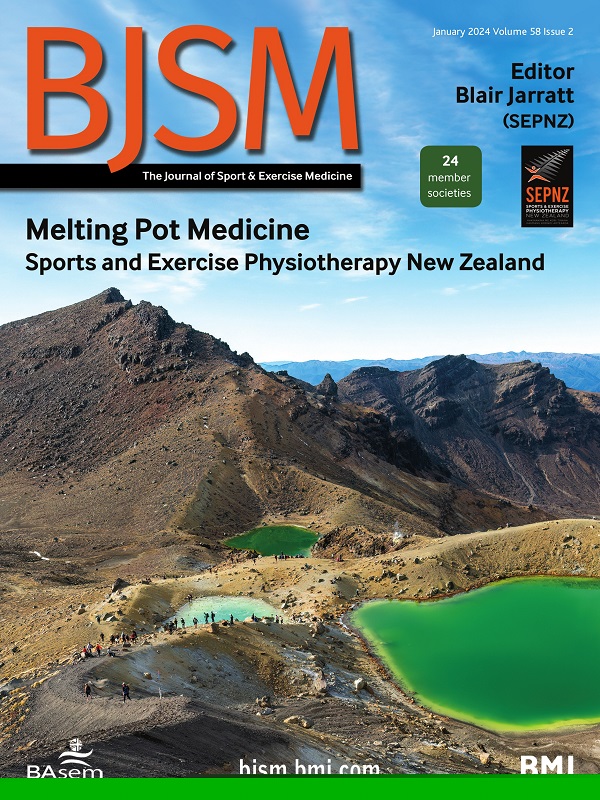设备测量的剧烈间歇性生活方式体育锻炼(VILPA)与主要不良心血管事件:性别差异的证据
IF 16.2
1区 医学
Q1 SPORT SCIENCES
引用次数: 0
摘要
背景 剧烈间歇性生活方式体力活动(VILPA)是指日常生活中的短暂剧烈运动。目的 研究VILPA与主要不良心血管事件(MACE)及其亚型之间剂量-反应关系的性别差异。方法 我们使用多变量调整立方样条,研究了英国生物数据库中不锻炼者(自述没有业余锻炼且每周休闲散步不超过一次的个人)的每日 VILPA 持续时间与总体 MACE 及其亚型(心肌梗死、心力衰竭和中风)的关系。我们还对锻炼者(自我报告每周参加一次以上闲暇锻炼和/或娱乐性步行的个人)的剧烈运动进行了类似分析。结果 在 7.9 年的随访中,13 018 名女性和 9350 名男性分别发生了 331 起和 488 起 MACE。在女性中,每日 VILPA 持续时间与所有 MACE、心肌梗死和心力衰竭呈近似线性的剂量反应关系。在男性中,剂量反应曲线不那么清晰,统计意义也不明显。与未服用 VILPA 的女性相比,女性每日 VILPA 的中位持续时间为 3.4 分钟与所有 MACE 的危险比(HRs;95% 置信区间)为 0.55(0.41 至 0.75),与心力衰竭的危险比(HRs)为 0.33(0.18 至 0.59)。女性每天服用 1.2-1.6 分钟 VILPA 的最低剂量与所有 MACE 的相关 HR 值为 0.70(0.58 至 0.86),与心肌梗死的相关 HR 值为 0.67(0.50 至 0.91),与心力衰竭的相关 HR 值为 0.60(0.45 至 0.81)。对英国生物库加速度子研究中的运动者进行的同等分析表明,剂量反应中没有明显的性别差异。结论 在不锻炼的女性中,少量的 VILPA 与所有 MACE、心肌梗死和心力衰竭风险的大幅降低有关。VILPA 可能是一种很有前景的预防心血管疾病的体育锻炼目标,尤其是对于无法或不愿进行正规锻炼的女性而言。英国生物库(UK Biobank)提供了支持本研究结果的数据,但这些数据的可用性受到限制,因为这些数据是在获得许可的情况下用于本研究的,所以不对外公开。不过,如果作者提出合理要求,并获得英国生物库的许可,可以获得这些数据。ES 和 MA 可以完全访问研究中的所有数据,并对数据的完整性和数据分析的准确性负责。本手稿分析中使用的统计代码可应要求提供。作者已将多篇类似手稿的统计代码存档,例如 .本文章由计算机程序翻译,如有差异,请以英文原文为准。
Device-measured vigorous intermittent lifestyle physical activity (VILPA) and major adverse cardiovascular events: evidence of sex differences
Background Vigorous intermittent lifestyle physical activity (VILPA) refers to brief bouts of intense physical activity embedded into daily life. Objective To examine sex differences in the dose–response association of VILPA with major adverse cardiovascular events (MACE) and its subtypes. Methods Using multivariable-adjusted cubic splines, we examined the associations of daily VILPA duration with overall MACE and its subtypes (incident myocardial infarction, heart failure and stroke) among non-exercisers (individuals self-reporting no leisure-time exercise and no more than one recreational walk per week) in the UK Biobank. We also undertook analogous analyses for vigorous physical activity among exercisers (individuals self-reporting participation in leisure-time exercise and/or recreational walking more than once a week). Results Among 13 018 women and 9350 men, there were 331 and 488 all MACE, respectively, over a 7.9-year follow-up. In women, daily VILPA duration exhibited a near-linear dose–response association with all MACE, myocardial infarction and heart failure. In men, dose-reponse curves were less clear with less evidence of statistical signifigance. Compared with women with no VILPA, women’s median daily VILPA duration of 3.4 min was associated with hazard ratios (HRs; 95% confidence intervals) of 0.55 (0.41 to 0.75) for all MACE and 0.33 (0.18 to 0.59) for heart failure. Women’s minimum doses of 1.2–1.6 min of VILPA per day were associated with HRs of 0.70 (0.58 to 0.86) for all MACE, 0.67 (0.50 to 0.91) for myocardial infarction, and 0.60 (0.45 to 0.81) for heart failure. The equivalent analyses in UK Biobank’s accelerometry sub-study exercisers suggested no appreciable sex differences in dose–response. Conclusions Among non-exercising women, small amounts of VILPA were associated with a substantially lower risk of all MACE, myocardial infarction and heart failure. VILPA may be a promising physical activity target for cardiovascular disease prevention, particularly in women unable or not willing to engage in formal exercise. The data that support the findings of this study are available from the UK Biobank, but restrictions apply to the availability of these data, which were used under license for the current study, and so are not publicly available. Data are, however, available from the authors upon reasonable request and with permission of the UK Biobank. ES and MA had full access to all the data in the study and takes responsibility for the integrity of the data and the accuracy of the data analysis. The statistical code used in the analyses of this manuscript is available upon request. The authors have archived the statistical code of multiple similar manuscripts, e.g. .
求助全文
通过发布文献求助,成功后即可免费获取论文全文。
去求助
来源期刊
CiteScore
27.10
自引率
4.90%
发文量
217
审稿时长
3-8 weeks
期刊介绍:
The British Journal of Sports Medicine (BJSM) is a dynamic platform that presents groundbreaking research, thought-provoking reviews, and meaningful discussions on sport and exercise medicine. Our focus encompasses various clinically-relevant aspects such as physiotherapy, physical therapy, and rehabilitation. With an aim to foster innovation, education, and knowledge translation, we strive to bridge the gap between research and practical implementation in the field. Our multi-media approach, including web, print, video, and audio resources, along with our active presence on social media, connects a global community of healthcare professionals dedicated to treating active individuals.

 求助内容:
求助内容: 应助结果提醒方式:
应助结果提醒方式:


